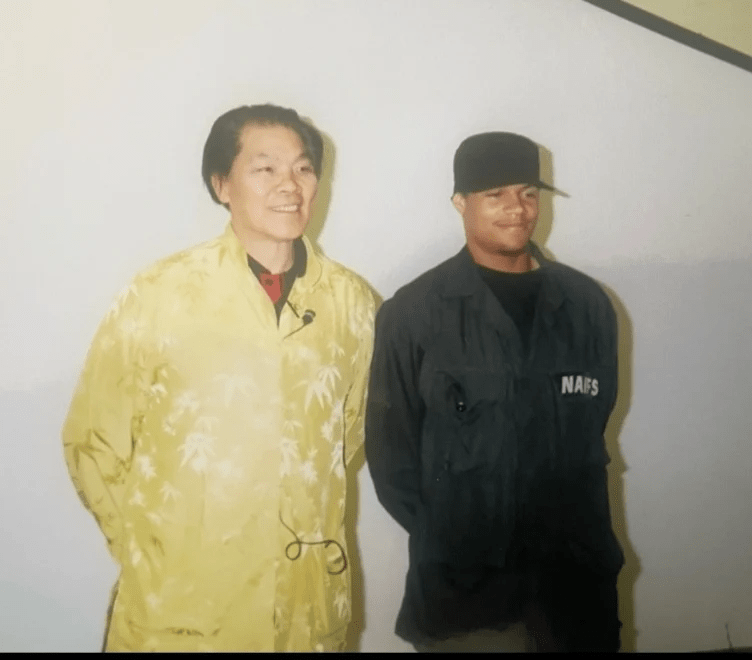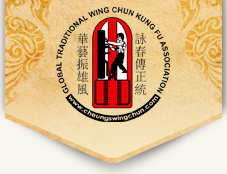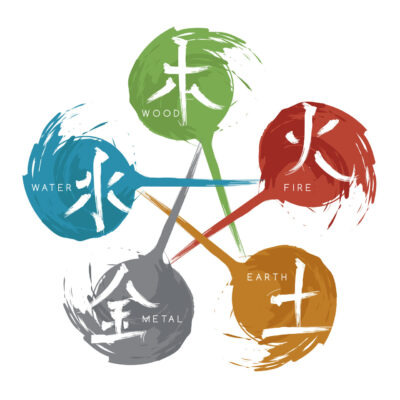Principles
The Wing Chun system can be used in close quarter fighting or distant fighting, as well as for self-defense and utilizes the following principles:
- Guard the Center
- Face the Point of Contact
- Economy of Movement
- Touch Reflexes: Chi Sao
- Watch the Leading Elbow
- Use Linear Striking Action
- Avoid Fighting Force Against Force
- Train to Use Two Arms at the Same Time
- Use Pressure Points to Make Striking Techniques More Effective
- Use the same Meridian Pressure Points as Treatment of Sports Injuries

SI-FU LEROY AND GRANDMASTER WILLIAM CHEUNG
Forms & Techniques
Wing Chun forms and techniques were developed and refined by a group of Shaolin Masters who needed to create a kung fu form that was most efficient and easy to learn.
Like all martial arts, it doesn’t matter how strong, quick, or intelligent you are, if you don’t take the time to properly learn the technique of the system.
Here are some pointers that can help you in your quest to perfecting your Wing Chun forms and techniques.
Forms & Techniques
- Empty Hands Forms
- Butterfly Swords
- Dragon Pole
- Wooden Dummy
- Chi Sao
- Form
- Drills/Techniques
Training Aids
At Wing Chun Kwoon, we follow the Shaolin Temple principles which require a practitioner to be not only a warrior, but a scholar. This means training in martial arts requires not just the physical aspects, but the intellectual and philosophical as well.
In addition to instructional videos and equipment, the following information is an introduction to:
- Wing Chun Terminology
- Chinese Acupuncture
- Five Element Theory
You can also learn about the Wing Chun Grading Structure and different level requirements.
Terminology
The Chinese language has hundreds of dialects. Some are so different they are like seperate launguages. Though they all read the same characters. Most westerners are exposed to Mandarin or Cantonese.
Kung Fu is Mandarin for Gung Fu. So Wing Chun Kung Fu is a mixture of two dialects. Wing Chun is Cantonese, so Wing Chun Gung Fu is correct in Cantonese. Yung Chun Kung Fu is correct in Mandarin.
We will use Kung Fu here because most people world wide are familiar with “Kung Fu”. Kung fu/gung fu means any acquired skill. A doctor, lawyer or a carpenter is doing kung fu. The proper term for the martial arts in Chinese is Wu Shu or Mo Sut.
Chi, or Qi is Mandarin for Hei in Cantonese. Chi will be used because of it’s familiarity.
| MANDARIN | CANTONESE | ENGLISH |
| Shaolin | Siu Lum | Small forest |
| Chi, Qi | Hei | Air, breath, intrinsic energy |
| Wu Mei | Ng Mui | Five Plums |
| Kung Fu | Gung Fu | Acquired skill |
| Wu Shu | Mo Sut | War Art, Martial Art |
| Yung Chun | Wing Chun | Speak of spring forever |
| Chuan | Kuen | Fist |
Cantonese translations
| Counting in Chinese | |
| Yat | One |
| Yee | Two |
| Saam | Three |
| Sei | Four |
| Ng | Five |
| Luhk | Six |
| Chaat | Seven |
| Baat | Eight |
| Gau | Nine |
| Sahp | Ten |
| Chinese Phrases | |
| Jeun Bai | Ready |
| Jeun Geung | Attack |
| Woo Wia | Defence |
| Sifu | Teacher |
| Sihing | Senior |
| Sidi | Junior |
| Haih | Yes |
| Ng Goi | Sorry |
| Do Jeh | Thank you |
| Jo-on | Good morning |
| Man-on | Good night |
| Ng-on | Good afternoon |
| Movement and Exercise | |
| Baat Jaam Do | Eight-chop broadswords (butterfly swords) |
| Biu Jee | Finger thrusting form |
| Bong Sao | Wing arm |
| Chi Sao | Sticky hand exercise |
| Muk Jong | Wooden dummy |
| Chum Kiu | Bridge seeking form |
| Fook Sao | Bridge-on arm |
| Gan Sao | Plowing hand |
| Kwan Sao | Tan and Bong deflection block |
| Gum Sao | Pinning hand |
| Jut Sao | Jerk hand |
| Kan Sao | Splitting block |
| Kuen | Fist |
| Fat Sao | Swinging arm |
| Pak Sao | Slapping block |
| Siu Lim Tao | Little idea form |
| Tan Sao | Palm-up arm |
| Wu Sao | Protecting arm |
| Dai Jeung | Reverse palm strike |
| Po Pai Jeung | Double palm strike |
| Jong | Elbow |
| Ma | Stance |
| Biu Sao | Stretching deflection block |
| Lau Sao | Slipping hand |
| Kwai Ma | Kneeling stance/horse |
| Yee Jee Kim Yang Ma | Character two pinching stance/horse |
Grading Structure
A student entering a kwoon to begin their training is given the White Sash of Level One Grade 0.
- Level 1-1, 1-2
- Level 2-0, 2-1, 2-2
- Level 3-0, 3-1, 3-2
- Level 4-0, 4-1, 4-2
- Level 5-0, 5-1, 5-2
- Level 6-0, 6-1, 6-2
- Level 7-0, 7-1, 7-2
- Level 8-0, 8-1, 8-2
- Level 9-0, 9-1, 9-2
- Instructor
- Master Levels
Five Element Theory
Yin and Yang are two Chinese words to explain the duality of the universe. Yin, meaning moon, soft, dark, yielding, etc. Yang, meaning sun, hard, light, overpowering, etc. Some say that yin and yang or opposites but they cannot exist without each other. They are both interdependent, and conflicting. The relationships between yin and yang are used in traditional Chinese medicine to explain the physiology and pathology of the human body. Yin and yang are also used as a guide in diagnosis and treatment of patients.
The Five Element Theory teaches that the material world is made up of 5 basic elements which are, wood, fire, earth, metal, and water. We can adapt to the environment, but we’re also dependent on it. The Five Element Theory has a generation cycle and a destruction cycle. Wood generates fire, fire generates earth, earth generates metal, metal generates water, and water generates wood.
Each of the five elements has a relationship the internal organs. (The pericardium is the membrane that surrounds the heart and is not considered an organ in western medicine. The triple heater or san jiao is also not an organ, but a function.

Wood
-
- Yin organ – liver
- Yang organ – gall bladder
- Season – Spring
- Weather – wind
- Color – green
- Direction – east
- Emotion – anger
- Sound – shout
- Flavor – sour
- Sense organ – eyes
- Sense commanded – sight
- Controls – muscles, nerves, tendons, ligaments,brain
- Expands into – nails
- Liquid emitted – tears
- Smell – rancid
- Developement – birth
- Grain – wheat
- Meat – fowl
- Martial art movement – retreat
- Weapon – staff
Earth
- Yin organ – spleen
- Yang organ – stomach
- Season – late summer
- Weather – humid
- Color – yellow
- Direction – center
- Emotion – saddness
- Sound – sing
- Flavor – sweet
- Sense organ – mouth
- Sense commanded – taste
- Controls – fat and flesh
- Expands into – lips
- Liquid – saliva/spinal fluid
- Smell – fragrant
- Development – transformation
- Grain – rye
- Meat – ox/beef
- Martial arts movement – center, balance
- Weapon – hand
Water
- Yin organ – kidney
- Yang organ – Urinary bladder
- Season – winter
- Weather- cold
- Color – black
- Direction – north
- Emotion – fear
- Sound – groaning
- Flavor – salty
- Sense organ – ears
- Sense commanded – hearing
- Controls – bones
- Expands into – head hair
- Liqud emitted – urine
- Smell – putrid
- Development – storing
- Grain – bean
- Meat – pork
- Martial arts movement – gaze left
- Weapon – sword
Fire
- Yin organ – heart/small intestine
- Yang organ – pericardium/triple heater
- Season – summer
- Weather – heat
- Color – red
- Direction – south
- Emotion – joy
- Sound – laughter
- Flavor – bitter
- Sense organ – tongue
- Sense commanded – speech
- Controls – blood vessels/vascular system
- Expands into – complexion
- Liquid emmitted – sweat
- Smell – scorched
- Development – growth
- Grain – millet
- Meat – lamb
- Martial arts movement – gaze right
- Weapon – spear
Metal
- Yin organ – lung
- Yang organ – colon
- Season – fall
- Weather – dryness
- Color – white
- Direction – west
- Emotion – grief
- Sound – weep
- Flavor – pungent
- Sense organ – nose
- Sense commanded – smell
- Controls – skin and hair
- Expands into – body hair
- Liquid emitted – mucous
- Smell – rank
- Develpoment – harvest
- Grain – rice
- Meat – horse
- Martial arts movement – advance
- Weapon – knife

